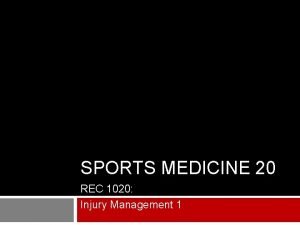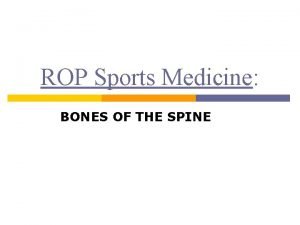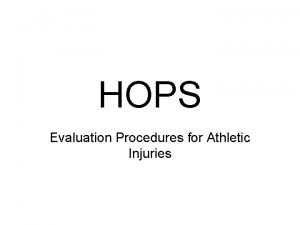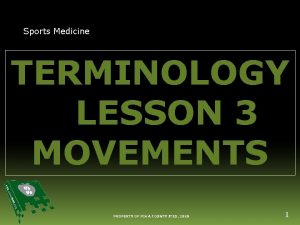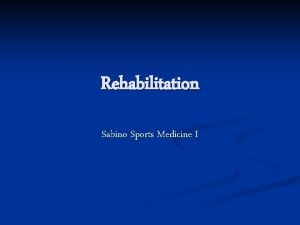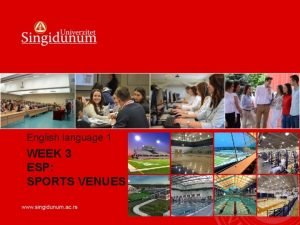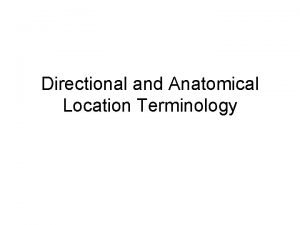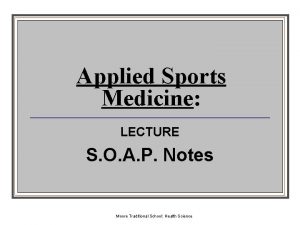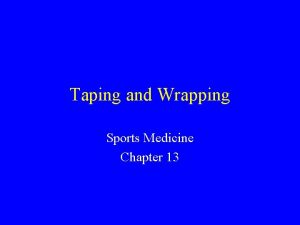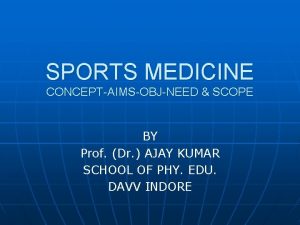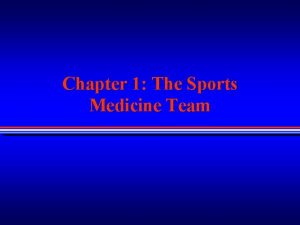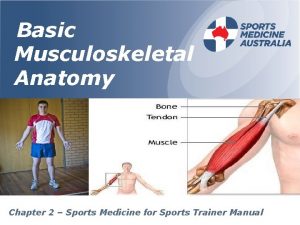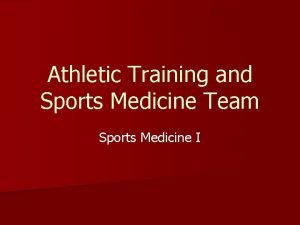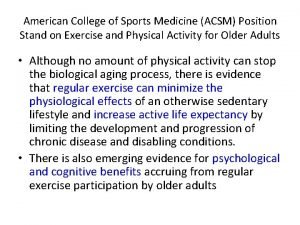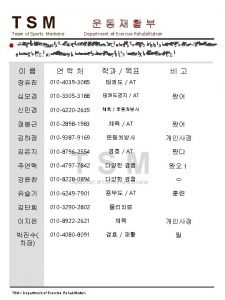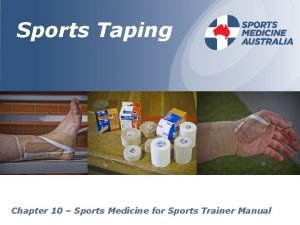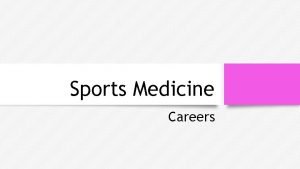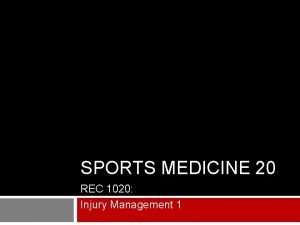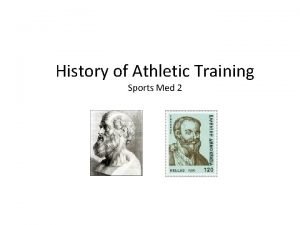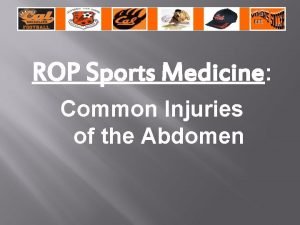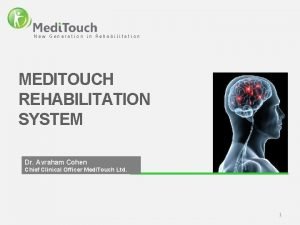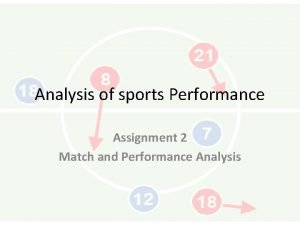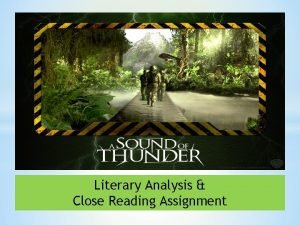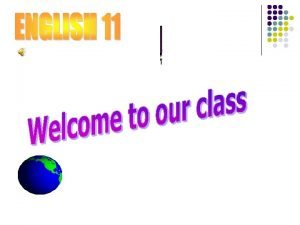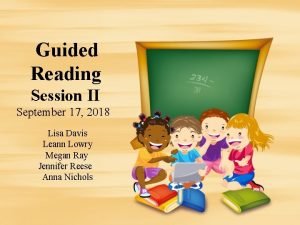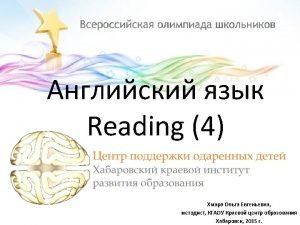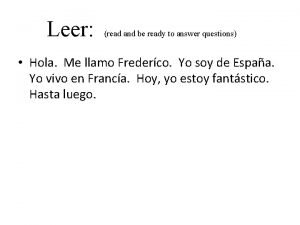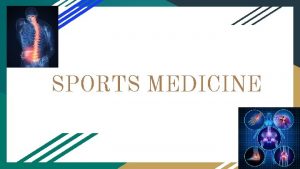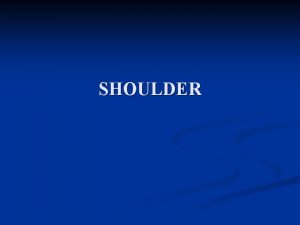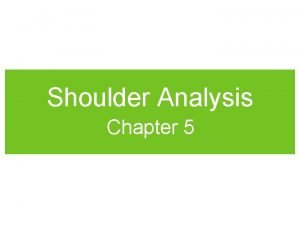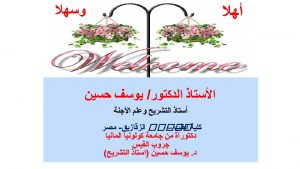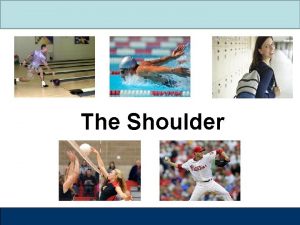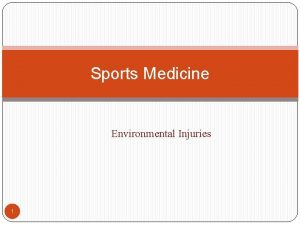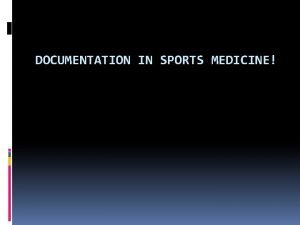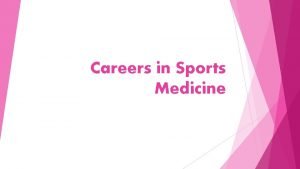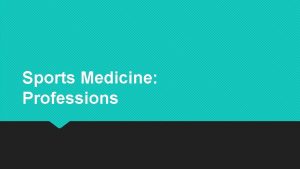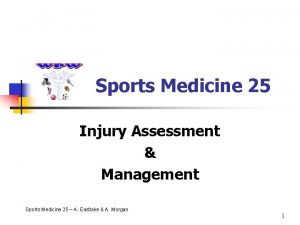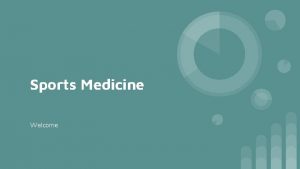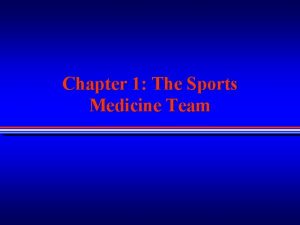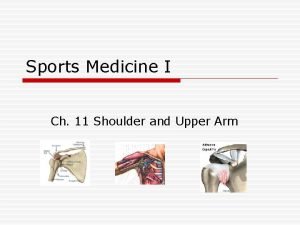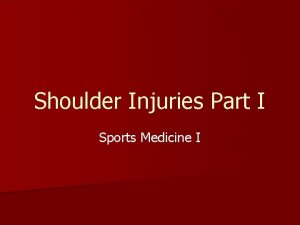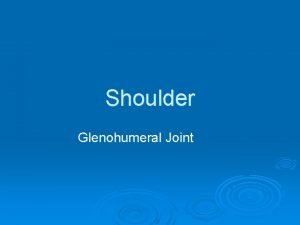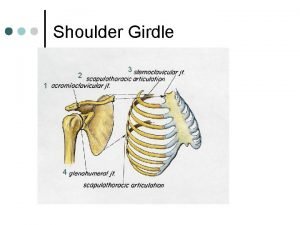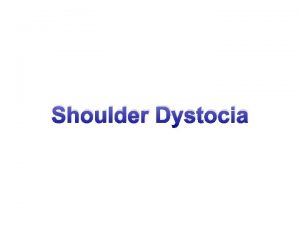Sports Medicine The Shoulder 1 Reading Assignment Read







































































- Slides: 71

Sports Medicine The Shoulder 1

Reading Assignment • Read pages 450 -451 and answer the following questions: 1. What three bones make up the shoulder girdle? 2. What three articulations make up the shoulder complex? 3. What bones make up each articulation? 2

Anatomy Review • Bones of the Shoulder Girdle: • _____________ • _______ • The shoulder complex is made up of four different articulations. • _________: (____) Formed by the head of the humerus and the glenoid fossa of the scapula. • __________: (____) Formed by the distal end of the clavicle and the acromion process of the scapula • __________: (____) Formed by the scapula and the thoracic cage. • __________: (______) Formed by the proximal end of the clavicle and the manubrium of the sternum. 3

Scapular Anatomy Review Glenoid Fossa Acromion Process Coracoid Process Spine Scapula 4

Humerus Anatomy Review Greater Tubercle Lesser Tubercle Bicipital Groove Head of Humerus 5

Movements of the Glenohumeral Joint • • Flexion Extension Adduction Abduction Internal Rotation External Rotation Horizontal Flexion Horizontal Extension 6

Movement of The Scapulothoracic Joint • • • Scapular Retraction Scapular Protraction Scapular Upward Rotation Scapular Downward Rotation Elevation Depression 7

Ligamentous Stability (Static) • Glenohumeral Joint • ______ Ligament • _______ Ligament • AC Joint • _______________ Ligament • ________ Ligament 8

Ligament Anatomy Review 9

Bony Shoulder Anatomy Review 10

Pace Lap • What are the four muscles that make up the rotator cuff? • 5 minutes 11

Reading Assignment • Please read pages 452 – 455 and answer the following questions: 1. What is the main function of the rotator cuff? 2. What four muscles make up the rotator cuff? 3. What movement do each produce? (Chart: Pg. 454) 4. Which superficial muscle act to elevate the arm? 5. What is a force couple? 12

Rotator Cuff Group of four muscles of the G-H joint. Subscapularis IR and ADD Supraspinatus ABD Infraspinatus ER Teres Minor ER Functions Stabilization of the head of the humerus in the glenoid fossa. 13

Anterior Rotator Cuff Anatomy 14

Posterior Rotator Cuff Anatomy 15

Glenohumeral Joint • ________ • Add, IR, Flex/Ext. • _________ • Ext, Add, IR • ________ • Abd, IR, Ext/ER, Flex/IR • _________ • Add, IR • __________ • Flex, Add. 16

Scapulothoracic Joint • ________ • Scapular Elevation • _______ • Scapular Retraction • Downward Rotation • _________ • Elevation • Retraction • Upward Rotation • Depression • _________________ • Protraction • Upward Rotation • ________ • Depression • Stabilization of the SC joint 17

Posterior Muscular Anatomy Review 18

Anterior Muscular Anatomy Review 19

Brachial Plexus 20

Common Sports Injuries • Injuries are common due to the wide range of motion in the _________ joint. • A lot of the injuries to the shoulder complex are sport specific • Types of Injuries • Fractures • Subluxation / Dislocations • Sprains • Strains 21

Soft-Tissue Injuries • Ligament Injuries • A-C Injuries • G-H Injuries • S-C Injuries • Muscular Injuries • • Rotator Cuff Injuries Biceps Tendon Injuries Impingement Syndrome Contusions 22

Fractures • Clavicle Fracture • Scapular Fractures 23

Pace Lap • What is the main function of the rotator cuff muscles? • 5 minutes 24

Anterior View 25

Posterior View 26

Assignment Read pages 464 and 466 and answer the following questions: 1. What are the two types of Rotator Cuff Tears? 2. Which one requires surgery and which one can be treated non-operatively? 3. What are some signs and symptoms of a full thickness rotator cuff tear? 27

Rotator Cuff Injury • Two Types • ________ Thickness • Partial tear of the rotator cuff tendon. • ________ • _____ Thickness • Complete tear of the rotator cuff tendon. • Requires _______ 28

Mechanism of Rotator Cuff Injuries Commonly occur as overuse injuries in the throwing athlete. Throwing can be broken down into five phases: 1. ________ 2. ________ 3. ________ 4. ________ 5. ________ 29

Phases of a Baseball Pitch http: //www. pbats. com 30

Signs and Symptoms Pain within the shoulder especially during the ______ phase of throwing or swinging. Pain and difficulty with ______ and external rotation (90/90) of the arm. Pain and stiffness _____ hours post practice or competition that involved throwing or swinging. Point tenderness around the _____ head deep within the deltoid muscle. 31

Prevention is the Key • _________________ • A well designed _______ strengthening program is essential. • Focus on training each individual rotator cuff muscle. • • ___________________ Combination of these movements • _______ training is a must. 32

Assignment • With a partner • Design a 5 step warm-up program for an overhead athlete. • Include the parameters (how long, how often, etc) • You have access to: • UBE upper body ergometer • Therabands/Theratubes • Manual Therapy 33

Treatment of Rotator Cuff Injury • Application of ice to relieve pain and swelling. • Discontinue activity. • Refer to physician for further evaluation. • Some rotator cuff injuries can be treated non-operatively (Partial-Thickness Tear) • Some must be surgically repaired. (Full. Thickness Tear) • Why? ? ? (Think Stabilization) 34

Assignment • Read pages 458 -461 and answer the following questions: • What is impingement syndrome? • What three structures are found in the subacromial space? • What are the signs and symptoms of impingement syndrome? 35

Glenohumeral Joint-Related Impingement Syndrome Anatomy • _______ Space • Acromion Process and the Coracoacromial ligament. (Coracoacromial _______ or ______) • The Glenohumeral joint capsule. (____) 36

The Subacromial Space • When the arm is _______ this space _______ in size. • Contents • Long head of the ______ tendon and joint capsule. • _______ bursa • ________ tendon (most common) • Anything that causes a decrease in the size of the subacromial space can cause an ________ of one or more of these structures. 37

Common Causes Rotator Cuff Patholgy Congenital defects of the coracoacromial arch. Odd shaped acromion. Biceps Tendonitis Supraspinatus Tendonitis Bone Spurs on the inferior part of the acromion. Subacromial Bursitis 38

Subacromial Space 39

Why is this a problem? • Athletes that place the arm _______ during their sport can often suffer from impingement syndrome. • The signs and symptoms often mimic those of a ________ tear. 40

Signs and Symptoms G-H pain Pain when the G-H joint is actively ______ and ___________. Point tenderness in the Subacromial Space. Limited ______ Confirmation with special test. ____________ 41

Treatment Rest Anti-inflammatory drugs Rehabilitation Strengthen RC and Surrounding Shoulder Muscles. When all else fails surgery may be required to open up the subacromial space. (________) 42

Pace Lap • What structures are found in the subacromial space? • 5 minutes 43

Assignment • Read page 466 and 469 and answer the following questions: • What is DOMS? • What does PRICE stand for? • What is Biceps Tendonitis? • Get with a partner and palpate the Biceps tendon in the bicipital groove. 44

Biceps Tendon Injuries • Long Head of the Biceps Tendon • Runs through the _____ groove of the humerus. • Originates from the supraglenoid tubercle. • Lies within the _____ capsule and subacromial space just beneath the acromion process. (Subacromial Space). • This puts the tendon at risk for impingement when the arm is _____. 45

Biceps Tendon Anatomy 46

Biceps Tendonitis Will develop ______ over time. As it become inflamed, it no longer fits in the ______ groove and becomes prone to _______. It is usually held in place by the ___________. This subluxation can also occur acutely with an extreme force commonly generated in throwing. 47

Signs and Symptoms of a Biceps Tendon Injury • Painful abduction of the shoulder. • Pain in the shoulder when the forearm is ______against resistance. • Subluxation of the biceps tendon when the forearm is _______ and _____ against resistance. • Pain with shoulder ____ with the elbow _______. 48

Treatment • Ice and compression if a subluxation occurs. • Rest • Anti-inflammatory drugs • Progressive rehabilitation. • Surgery may be required if chronic subluxation occurs. 49

Pace Lap • What are three signs and symptoms of impingement syndrome? • What are three methods of treatment? • 5 minutes 50

Other Overuse Soft Tissue Injuries Muscle Strains Can be overuse or traumatic. Often occur at the start of the sports season or with an increase in activity. Signs and Symptoms Pain and tenderness over the _____. (Palpation) Pain with muscle contraction. Pain may be delayed. (________) Treatment _________ Anti-inflammatory drugs Gentle Stretching 51

Reading Assignment Read pages 468 -470 and answer the following questions: 1. What are the four most common traumatic shoulder injuries? 2. Which direction do most shoulder dislocations occur? 3. What is the mechanism for an anterior shoulder dislocation? What type of activity/sport may cause this? 4. What is the re-injury rate of a shoulder dislocation for an 18 year old athlete. 52

Traumatic Shoulder Injuries • Glenohumeral Joint Dislocations • Acromioclavicular Sprain • Fractures • Tendon Ruptures 53

Glenohumeral Dislocations • The _____ head is forced out of the _____ cavity. • Can occur in the following directions: • _________ (Front and Down) • ______ (Back) • ______ (Down) • ______ Dislocation is the most common (95%) 54

Anterior/Inferior G-H Joint Dislocation 55

G-H Joint Dislocations/Subluxations Mechanism of Injury Shoulder ____ with ______ Rotation. Tackling with outstretched arm. Signs and Symptoms Possible ______ of the shoulder ______ arm on affected side Palpable head of Humerus in _____. Partially _______ arm with _______ elbow. Pain with any G-H movement. 56

57

Treatment of G-H Dislocation/Subluxation • Apply Ice to shoulder and secure with Ace Wrap or Plastic Wrap. Place _____ roll under the axilla. • Apply standard ______ and _____. • Refer to physician for immediate reduction and X-Rays. • Treat for _____ if necessary. 58

Complications of G-H Injuries • ____% of all G-H dislocations will recur in athletes younger than ____ years old. • Why? ? • This is due to the stretching of the ______ and _____ of the supporting musculature. • May have to be surgically repaired. • Chronic dislocation/subluxation can also cause an injury to the glenoid _______. 59

Assignment • Read page 470 -471 and answer the following questions: 1. What is the glenoid labrum and where is it located? 2. What is the function of the Glenoid Labrum? 3. What are the signs and symptoms of a Glenoid Labrum tear or injury? 4. How would you treat a glenoid labrum tear? 60

Glenoid Labrum • A ring of ____ attached to the margin of the glenoid cavity. 61

Glenoid Labrum • Functions to help ____ the head if the humerus within the glenoid cavity. • Mechanism of Injury • Traumatic _____ of the shoulder. • ______ Tear: • Repetitive stress due to an ______. (GH joint being too loose). 62

Glenoid Labrum Tear • Signs and Symptoms • • Pain deep within the shoulder. _____ or ______ when the shoulder is rotated. Shoulder weakness. Decrease ability to use the arm. • Treatment • Refer to physician for diagnosis. • MRI, X-Ray • Surgery may be required. • Shoulder strengthening program. • Rotator Cuff 63

Assignment • Read the section titled “Acromioclavicular Injuries” on pages 473 -474 and answer the following questions. 1. What two boney structures form the A-C joint? 2. What is the number one mechanism of injury for an A-C sprain? 3. How would you care for someone with an A -C joint injury? 64

Acromioclavicular Joint Articulation between the distal end of the _____ and the _____. Soft Tissue Support Anterior Deltoid Muscles Trapezius Muscles Acromioclavicular Ligaments Superior Inferior Coracoclavicular ligament Trapezoid ligament Conoid ligament. 65

Types of A-C Injuries Three types of Injuries 1. _____: A-C ligament is partially injured. The articulation is stable. Pain is the primary symptom. ** 2. ____: AC joint capsule and CC ligaments partially disrupted. Articulation is stable. 3. _____: AC joint capsule and CC ligaments completely disrupted. Superior displacement of the clavicle. (____ key sign) 1. AKA: Shoulder Separation ohttp: //biomed. brown. ed u/Courses/BI 108_2 004_Groups/Group 01/mec h. SSD. htm 66

A-C Joint Injuries Cont. Mechanism of Injury _____ blow to the outer end of the clavicle. Fall forward on an outstretched arm. _______ Signs and Symptoms Swelling Point-Tenderness Discoloration Pain with any movement Horizontal Flexion + Piano Key Sign (Grade __ only) 67

Treatment for an A-C Injury • Application of Ice Pack secured with Ace Wrap or Plastic Wrap. • Apply sling and swath bandage. • Refer to physician for X-ray. • Immediately for Grade III or if signs or shock are present. • Possible Surgical Intervention may be required. 68

Clavicle Fracture • Most occur at the mid-shaft of the bone. • This is the thin/flat portion. 69

Clavicle Fracture Mechanism of Injury Direct Blow Fall on outstretched hand or tip of shoulder. FOOSH Signs and Symptoms Swelling or deformity (Could be an _____ fracture) Discoloration Point tenderness Pain with ______ flexion Athlete may hear or feel a “______” Athlete will be holding the arm in a _______ position. Treatment Treat for shock Immobilize Use ice pack Apply a sterile dressing to any wounds. Arrange for transport to a medical facility. 70

Greenstick Fracture (Clavicle) • Commonly happens to ______- athletes. 71
 While reading activities
While reading activities Medicine wheel
Medicine wheel Sports medicine definition
Sports medicine definition Rop sports medicine
Rop sports medicine What is hops in sports medicine
What is hops in sports medicine What is hops in sports medicine
What is hops in sports medicine Healthcare and the healthcare team chapter 2
Healthcare and the healthcare team chapter 2 Sports medicine terminology
Sports medicine terminology Meditouch sports medicine
Meditouch sports medicine Esp sports medicine
Esp sports medicine Flexion vs extension
Flexion vs extension Athletic training soap note example
Athletic training soap note example Athletic training taping techniques
Athletic training taping techniques Scope of sports medicine
Scope of sports medicine Sports medicine team project
Sports medicine team project Chapter 2 sports medicine
Chapter 2 sports medicine Sports med umbrella
Sports med umbrella Heel raise
Heel raise Sports medicine team definition
Sports medicine team definition Chapter 10 worksheet wrapping and taping techniques
Chapter 10 worksheet wrapping and taping techniques Sports medicine careers
Sports medicine careers Objective of sports medicine
Objective of sports medicine Athletic training sports medicine
Athletic training sports medicine Rop sports medicine
Rop sports medicine Meditouch orthopedics
Meditouch orthopedics Analysis of sports performance assignment 1
Analysis of sports performance assignment 1 Which of these sports are indoor
Which of these sports are indoor What is the climax in a sound of thunder
What is the climax in a sound of thunder Is playing
Is playing Shared reading vs read aloud
Shared reading vs read aloud Paragraph to read
Paragraph to read Shared reading vs read aloud
Shared reading vs read aloud Shared reading vs read aloud
Shared reading vs read aloud Difference between shared reading and read aloud
Difference between shared reading and read aloud Shared reading vs read aloud
Shared reading vs read aloud Task 2 read the text and answer the questions
Task 2 read the text and answer the questions Reading read and answer the questions en español
Reading read and answer the questions en español Hát kết hợp bộ gõ cơ thể
Hát kết hợp bộ gõ cơ thể Ng-html
Ng-html Bổ thể
Bổ thể Tỉ lệ cơ thể trẻ em
Tỉ lệ cơ thể trẻ em Chó sói
Chó sói Chụp tư thế worms-breton
Chụp tư thế worms-breton Chúa sống lại
Chúa sống lại Các môn thể thao bắt đầu bằng tiếng nhảy
Các môn thể thao bắt đầu bằng tiếng nhảy Thế nào là hệ số cao nhất
Thế nào là hệ số cao nhất Các châu lục và đại dương trên thế giới
Các châu lục và đại dương trên thế giới Cong thức tính động năng
Cong thức tính động năng Trời xanh đây là của chúng ta thể thơ
Trời xanh đây là của chúng ta thể thơ Mật thư anh em như thể tay chân
Mật thư anh em như thể tay chân 101012 bằng
101012 bằng Phản ứng thế ankan
Phản ứng thế ankan Các châu lục và đại dương trên thế giới
Các châu lục và đại dương trên thế giới Thể thơ truyền thống
Thể thơ truyền thống Quá trình desamine hóa có thể tạo ra
Quá trình desamine hóa có thể tạo ra Một số thể thơ truyền thống
Một số thể thơ truyền thống Cái miệng bé xinh thế chỉ nói điều hay thôi
Cái miệng bé xinh thế chỉ nói điều hay thôi Vẽ hình chiếu vuông góc của vật thể sau
Vẽ hình chiếu vuông góc của vật thể sau Thế nào là sự mỏi cơ
Thế nào là sự mỏi cơ đặc điểm cơ thể của người tối cổ
đặc điểm cơ thể của người tối cổ V cc cc
V cc cc Vẽ hình chiếu đứng bằng cạnh của vật thể
Vẽ hình chiếu đứng bằng cạnh của vật thể Fecboak
Fecboak Thẻ vin
Thẻ vin đại từ thay thế
đại từ thay thế điện thế nghỉ
điện thế nghỉ Tư thế ngồi viết
Tư thế ngồi viết Diễn thế sinh thái là
Diễn thế sinh thái là Dạng đột biến một nhiễm là
Dạng đột biến một nhiễm là Thế nào là số nguyên tố
Thế nào là số nguyên tố Tư thế ngồi viết
Tư thế ngồi viết Lời thề hippocrates
Lời thề hippocrates


